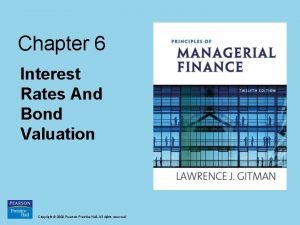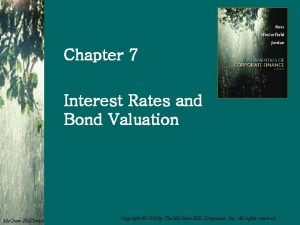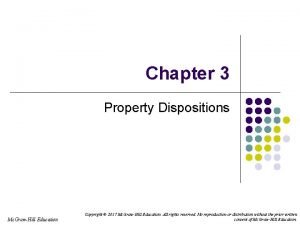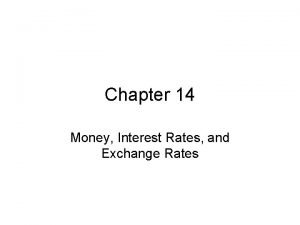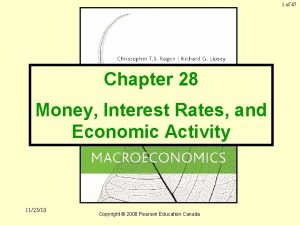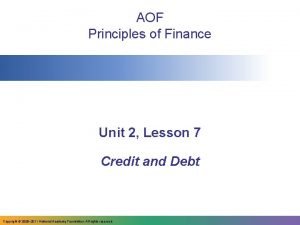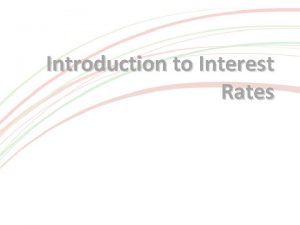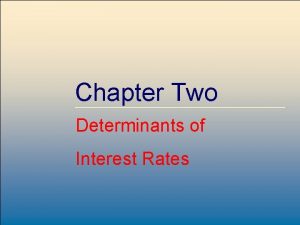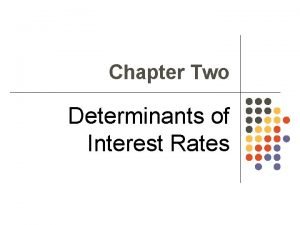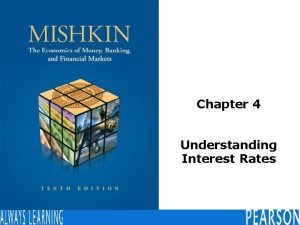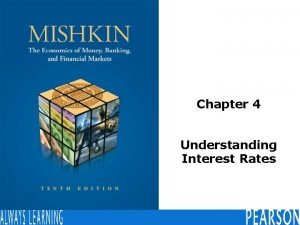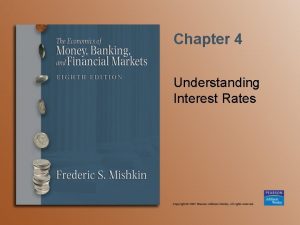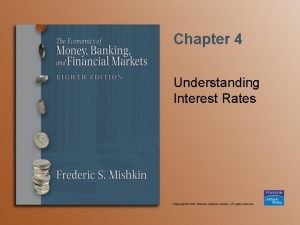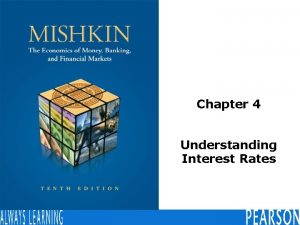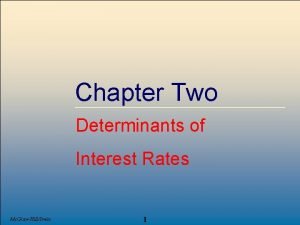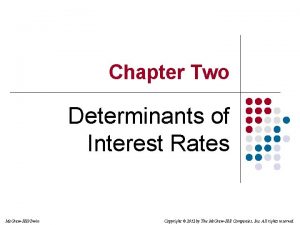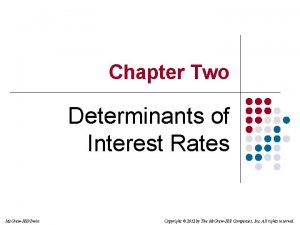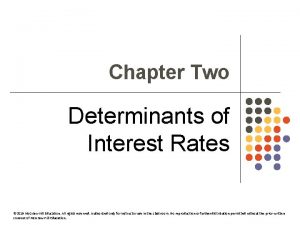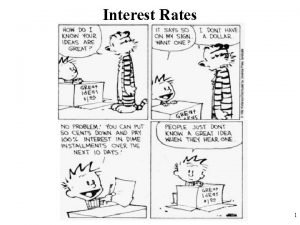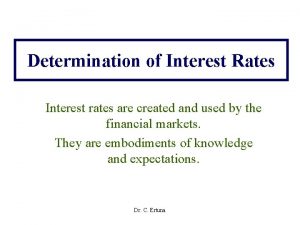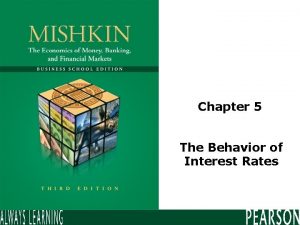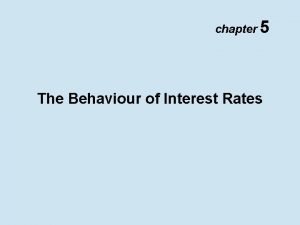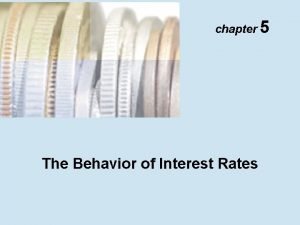Chapter Two Determinants of Interest Rates Mc GrawHill


























- Slides: 26

Chapter Two Determinants of Interest Rates Mc. Graw-Hill /Irwin Copyright © 2001 by The Mc. Graw-Hill Companies, Inc. All rights reserved.

Interest Rate Fundamentals • Nominal interest rates - the interest rate actually observed in financial markets – directly affect the value (price) of most securities traded in the market – affect the relationship between spot and forward FX rates Mc. Graw-Hill /Irwin Copyright © 2001 by The Mc. Graw-Hill Companies, Inc. All rights reserved.

Time Value of Money and Interest Rates • Assumes the basic notion that a dollar received today is worth more than a dollar received at some future date • Compound interest – interest earned on an investment is reinvested • Simple interest – interest earned on an investment is not reinvested Mc. Graw-Hill /Irwin Copyright © 2001 by The Mc. Graw-Hill Companies, Inc. All rights reserved.

Calculation of Simple Interest Value = Principal + Interest Example: $1, 000 to invest for a period of two years at 12 percent Value = $1, 000 + $1, 000(. 12)(2) = $1, 240 Mc. Graw-Hill /Irwin Copyright © 2001 by The Mc. Graw-Hill Companies, Inc. All rights reserved.

Value of Compound Interest Value = Principal + Interest + Compounded interest Value = $1, 000 + $1, 000(12)(2) = $1, 000[1 + 2(12) + (12)2] = $1, 000(1. 12)2 = $1, 254. 40 Mc. Graw-Hill /Irwin Copyright © 2001 by The Mc. Graw-Hill Companies, Inc. All rights reserved.

Present Values • PV function converts cash flows received over a future investment horizon into an equivalent (present) value by discounting future cash flows back to present using current market interest rate – lump sum payment • a single cash payment received at the end of some investment horizon – annuity • a series of equal cash payments received at fixed intervals over the investment horizon • PVs decrease as interest rates increase Mc. Graw-Hill /Irwin Copyright © 2001 by The Mc. Graw-Hill Companies, Inc. All rights reserved.

Calculating Present Value (PV) of a Lump Sum PV = FVn(1/(1 + i/m))nm = FVn(PVIFi/m, nm) where: PV = present value FV = future value (lump sum) received in n years i = simple annual interest n = number of years in investment horizon m = number of compounding periods in a year PVIF = present value interest factor of a lump sum Mc. Graw-Hill /Irwin Copyright © 2001 by The Mc. Graw-Hill Companies, Inc. All rights reserved.

Calculation of Present Value (PV) of an Annuity nm PV = PMT (1/(1 + i/m))t = PMT(PVIFA i/m, nm) t=1 where: PV = present value PMT = periodic annuity payment received during investment i = simple annual interest n = number of years in investment horizon m = number of compounding periods in a year PVIFA = present value interest factor of an annuity Mc. Graw-Hill /Irwin Copyright © 2001 by The Mc. Graw-Hill Companies, Inc. All rights reserved.

Calculation of Present Value of an Annuity You are offered a security investment that pays $10, 000 on the last day of every quarter for the next 6 years in exchange for a fixed payment today. PV = PMT(PVIFAi/m, nm) at 8% interest - = $10, 000(18. 913926) = $189, 139. 26 at 12% interest - = $10, 000(16. 935542) = $169, 355. 42 at 16% interest - = $10, 000(15. 246963) = $152, 469. 63 Mc. Graw-Hill /Irwin Copyright © 2001 by The Mc. Graw-Hill Companies, Inc. All rights reserved.

Future Values • Translate cash flows received during an investment period to a terminal (future) value at the end of an investment horizon • FV increases with both the time horizon and the interest rate Mc. Graw-Hill /Irwin Copyright © 2001 by The Mc. Graw-Hill Companies, Inc. All rights reserved.

Future Values Equations FV of lump sum equation FVn = PV(1 + i/m)nm = PV(FVIF i/m, nm) FV of annuity payment equation (nm-1) FVn = PMT (1 + i/m)t = PMT(FVIFAi/m, mn) (t = 1) Mc. Graw-Hill /Irwin Copyright © 2001 by The Mc. Graw-Hill Companies, Inc. All rights reserved.

Relation between Interest Rates and Present and Future Values Present Value (PV) Future Value (FV) Interest Rate Mc. Graw-Hill /Irwin Copyright © 2001 by The Mc. Graw-Hill Companies, Inc. All rights reserved.

Equivalent Annual Return (EAR) Rate returned over a 12 -month period taking the compounding of interest into account EAR = (1 + i/m)m - 1 At 8% interest - EAR = (1 +. 08/4)4 - 1 = 8. 24% At 12% interest - EAR = (1 +. 12/4)4 - 1 = 12. 55% Mc. Graw-Hill /Irwin Copyright © 2001 by The Mc. Graw-Hill Companies, Inc. All rights reserved.

Loanable Funds Theory • A theory of interest rate determination that views equilibrium interest rates in financial markets as a result of the supply and demand for loanable funds Mc. Graw-Hill /Irwin Copyright © 2001 by The Mc. Graw-Hill Companies, Inc. All rights reserved.

Supply of Loanable Funds Interest Rate Demand Supply Quantity of Loanable Funds Supplied and Demanded Mc. Graw-Hill /Irwin Copyright © 2001 by The Mc. Graw-Hill Companies, Inc. All rights reserved.

Funds Supplied and Demanded by Various Groups (in billions of dollars) Funds Supplied Households Business -- nonfinancial Business -- financial Government units Foreign participants Mc. Graw-Hill /Irwin $31, 866. 4 7, 400. 0 27, 701. 9 6, 174. 8 6, 164. 8 Funds Demanded $ 6, 624. 4 30, 356. 2 29, 431. 1 10, 197. 9 2, 698. 3 Copyright © 2001 by The Mc. Graw-Hill Companies, Inc. All rights reserved.

Determination of Equilibrium Interest Rates D S Interest Rate IH i E IL Q Mc. Graw-Hill /Irwin Quantity of Loanable Funds Supplied and Demanded Copyright © 2001 by The Mc. Graw-Hill Companies, Inc. All rights reserved.

Effect on Interest rates from a Shift in the Demand Curve for or Supply curve of Loanable Funds Increased supply of loanable funds Increased demand for loanable funds Interest Rate SS DD DD SS* i* E E* i** Q* Q** Mc. Graw-Hill /Irwin i* Quantity of Funds Supplied DD* E Q* Q** SS E* Quantity of Funds Demanded Copyright © 2001 by The Mc. Graw-Hill Companies, Inc. All rights reserved.

Factors Affecting Nominal Interest Rates • Inflation – continual increase in price of goods/services • Real Interest Rate – nominal interest rate in the absence of inflation • Default Risk – risk that issuer will fail to make promised payment (continued) Mc. Graw-Hill /Irwin Copyright © 2001 by The Mc. Graw-Hill Companies, Inc. All rights reserved.

• Liquidity Risk – risk that a security can not be sold at a predictable price with low transaction cost on short notice • Special Provisions – taxability – convertibility – callability • Time to Maturity Mc. Graw-Hill /Irwin Copyright © 2001 by The Mc. Graw-Hill Companies, Inc. All rights reserved.

Inflation and Interest Rates: The Fischer Effect The interest rate should compensate an investor for both expected inflation and the opportunity cost of foregone consumption (the real rate component) i = Expected (IP) + RIR Example: 5. 08% - 2. 70% = 2. 38% Mc. Graw-Hill /Irwin Copyright © 2001 by The Mc. Graw-Hill Companies, Inc. All rights reserved.

Default Risk and Interest Rates The risk that a security’s issuer will default on that security by being late on or missing an interest or principal payment DRPj = ijt - i. Tt Example: DRPAaa = 7. 55% - 6. 35% = 1. 20% DRPBbb = 8. 15% - 6. 35% = 1. 80% Mc. Graw-Hill /Irwin Copyright © 2001 by The Mc. Graw-Hill Companies, Inc. All rights reserved.

Tax Effects: The Tax Exemption of Interest on Municipal Bonds Interest payments on municipal securities are exempt from federal taxes and possibly state and local taxes. Therefore, yields on “munis” are generally lower than on equivalent taxable bonds such as corporate bonds. im = ic(1 - ts - t. F) Where: Mc. Graw-Hill /Irwin ic = im = ts = t. F = Interest rate on a corporate bond Interest rate on a municipal bond State plus local tax rate Federal tax rate Copyright © 2001 by The Mc. Graw-Hill Companies, Inc. All rights reserved.

Term to Maturity and Interest Rates: Yield Curve (a) Upward sloping (b) Inverted or downward sloping (c) Humped (d) Flat Yield to Maturity (a) (d) (b) (c) Time to Maturity Mc. Graw-Hill /Irwin Copyright © 2001 by The Mc. Graw-Hill Companies, Inc. All rights reserved.

Term Structure of Interest Rates • Unbiased Expectations Theory – at a given point in time, the yield curve reflects the market’s current expectations of future short-term rates • Liquidity Premium Theory – investors will only hold long-term maturities if they are offered a premium to compensate for future uncertainty in a security’s value • Market Segmentation Theory – investors have specific maturity preferences and will demand a higher maturity premium Mc. Graw-Hill /Irwin Copyright © 2001 by The Mc. Graw-Hill Companies, Inc. All rights reserved.

Forecasting Interest Rates Forward rate is an expected or “implied” rate on a security that is to be originated at some point in the future using the unbiased expectations theory _ _ R 2 = [(1 + R 1)(1 + (f 2))]1/2 - 1 where f 2 = expected one-year rate for year 2, or the implied forward one-year rate for next year Mc. Graw-Hill /Irwin Copyright © 2001 by The Mc. Graw-Hill Companies, Inc. All rights reserved.
 Determinants of interest rates
Determinants of interest rates Chapter 7 interest rates and bond valuation
Chapter 7 interest rates and bond valuation Chapter 5 bonds bond valuation and interest rates solutions
Chapter 5 bonds bond valuation and interest rates solutions Chapter 6 interest rates and bond valuation
Chapter 6 interest rates and bond valuation Chapter 7 interest rates and bond valuation
Chapter 7 interest rates and bond valuation Chapter 6 interest rates and bond valuation
Chapter 6 interest rates and bond valuation What is a unit ratio
What is a unit ratio Equivalent ratios
Equivalent ratios Ratios rates and unit rates
Ratios rates and unit rates Ratios rates and unit rates
Ratios rates and unit rates Grawhill
Grawhill Grawhill
Grawhill Grawhill
Grawhill Grawhill
Grawhill Mc grawhill
Mc grawhill Single user multitasking os
Single user multitasking os Grawhill
Grawhill Mc grawhill
Mc grawhill Grawhill
Grawhill Ssema
Ssema Money market graph expansionary monetary policy
Money market graph expansionary monetary policy Disadvantages of high interest rates
Disadvantages of high interest rates Quotes about adjustments
Quotes about adjustments Increase money supply
Increase money supply Interest rates and price level
Interest rates and price level Nominal interest rate
Nominal interest rate Economics unit 2 lesson 7
Economics unit 2 lesson 7



